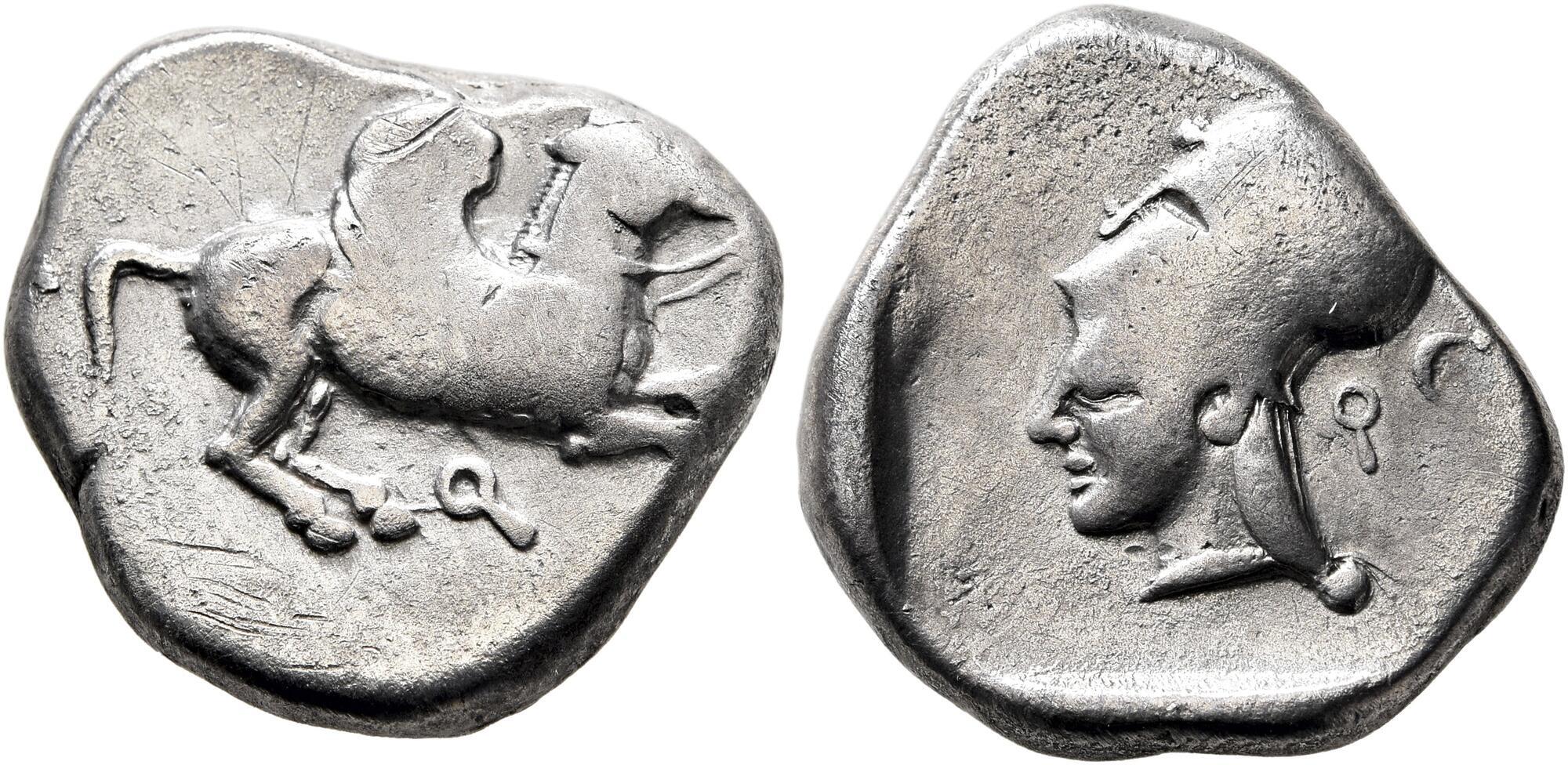449 BCE - 440 BCE | TARAΣ
Overstriking coin
Taras_on_Corinth_-_Oxford, _AM, _223.jpg
[1]
Overstruck variety
Corinth_athena_incuse_l..jpg
[2]
Description
| ObverseInscription or printing placed on the obverse.:
|
Male character (Taras or Phalanthos), nude, seated on dolphin to left, arms outrechts. Above, ?. Below, shell.
|
ReverseInscription or printing placed on the reverse.:
|
TARAΣ (Greek) Oecist seated left, drapery on legs, holding distaff with right hand and his seat with left hand.
|
Mint and issuing power
| MintIdentifies the place of manufacture or issue of a numismatic object.:
|
Taras
|
Ancient regionAncient region.
|
Calabria
|
Modern countryModern country: Italy
|
AuthorityIdentifies the issuing power. The authority can be "pretended" when the name or the portrait of X is on the coin but he/she was not the issuing power. It can also be "uncertain" when there is no mention of X on the coin but he/she was the issuing power according to the historical sources:
|
|
Chronology
| FromIdentifies the initial date in a range assigned in a numismatic context. 449 BCE toIdentifies the final date in a range assigned in a numismatic context.. 440 BCE
|
Classical 480-323 BC  periodTime period of the numismatic object. periodTime period of the numismatic object.
|
Physical description
MetalThe physical material (usually metal) from which an object is made.: Silver 
|
WeightWeight of the numismatic object (in grams). in grams: 7.967.96 g <br />7,960 mg <br />
|
DenominationTerm indicating the value of a numismatic object. Examples: tetradrachm, chalkous, denarius.: nomos
|
AxisDescribes the directional relationship between the obverse and reverse of a numismatic object.: 88 mm <br />0.8 cm <br />
|
| DiameterDescribes diameter of an object (in mm).: 2424 mm <br />2.4 cm <br />
|
StandardStandard.: Achaian
|
References
| Coin referenceReference of the Coin:
|
Ravel 1947, n° T237, Noe 1957, group VII, p. 32, pl. XI, e, SNG Ashmolean 1A Etruria-Lucania, n° 223
|
Coin series referenceReference to coin series study:
|
Ravel 19471Ravel 1947, n° T237, Noe 19572Noe 1957, group VII, p. 32, pl. XI, e, SNG Ashmolean 1A Etruria-Lucania3SNG Ashmolean 1A Etruria-Lucania, n° 223, Fischer-Bossert 19994Fischer-Bossert 1999, n° 269, HN Italy5HN Italy, n° 843-846, HGC 16HGC 1, n° 757-759
|
| Coin series web referenceCoin series web references:
|
|
Description
| ObverseInscription or printing placed on the obverse.:
|
Pegasus flying
|
ReverseInscription or printing placed on the reverse.:
|
Head of Athena, wearing helmet
|
Mint and issuing power
| MintIdentifies the place of manufacture or issue of a numismatic object. ᵖ:
|
Corinth
|
Ancient regionAncient region. ᵖ
|
Peloponnesus
|
Modern countryModern country: Greece
|
AuthorityIdentifies the authority in whose name (explicitly or implicitly) a numismatic object was issued. ᵖ:
|
|
Chronology
| FromIdentifies the initial date in a range assigned in a numismatic context. 510 BCE toIdentifies the final date in a range assigned in a numismatic context.. 480 BCE
|
Archaic until 480 BC  periodTime period of the numismatic object. periodTime period of the numismatic object.
|
Physical description
| DenominationTerm indicating the value of a numismatic object. Examples: tetradrachm, chalkous, denarius. ᵖ:
|
stater 
|
StandardStandard. ᵖ:
|
Aeginetic
|
References
References
- ^ Ravel, Oscar E. (1990), Descriptive catalogue of the collection of Tarentine coins formed by M. P. Vlasto, London, Spink
- ^ Noe, Sydney P. (1957), "Overstrikes in Magna Graecia", American Numismatic Society. Museum Notes 7, p. 13-42, pl. 5-14.
- ^ Kraay, Colin M. (1962), Sylloge Nummorum Graecorum. Great Britain V, Ashmolean Museum, Oxford. Part 1A: Italy: Etruria - Lucania (Thurium), London.
- ^ Fischer-Bossert, Wolfgang (1999), Chronologie der Didrachmenprägung von Tarent, 510-280 v. Chr., Berlin, De Gruyter, xvii, 495 p., [84] pl.
- ^ Rutter N. Keith et alii (eds.) (2001), Historia Numorum Italy, London, xvi, 223 p., 43 pl.
- ^ Hoover, Oliver D. (2018), The Handbook of Greek Coinage Series, Volume 1. Handbook of Coins of Italy and Magna Graecia, Sixth to First Centuries BC., Lancaster-London, 2018, lxi, 527 pages, 23 cm
- ^ Ravel, Oscar E (1936), Les "Poulains" de Corinthe : monographie des statères corinthiens. Tome I: de 650 à 415 J.-C., Basel.
- ^ Calciati, Romolo (1990), Pegasi, Mortara, Edizioni I.P..

